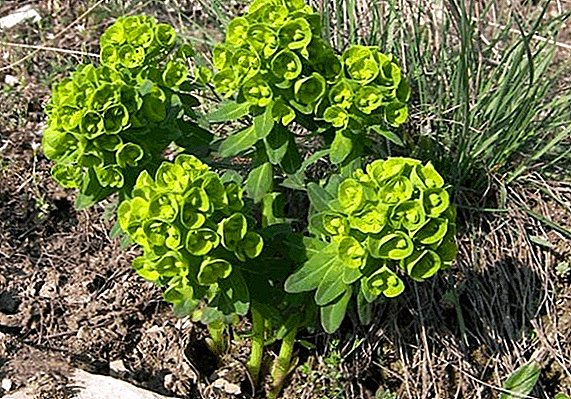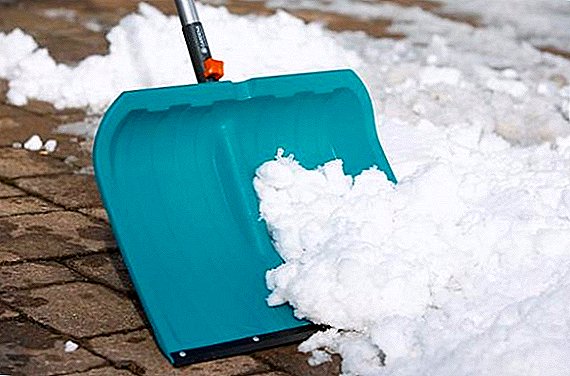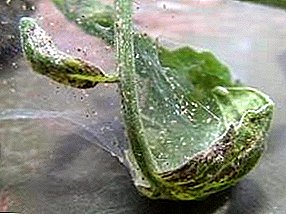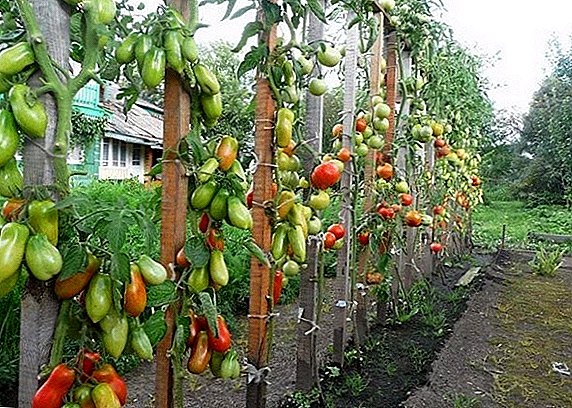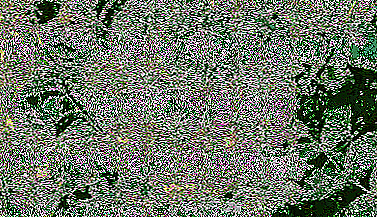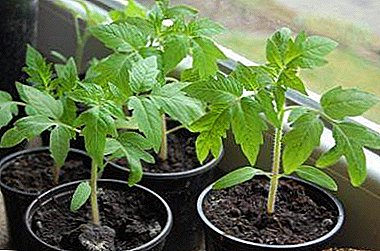
Tomatoes occupy a prominent place in our daily diet, and, undoubtedly, many are wondering how you can grow them yourself at home.
Not everyone has the opportunity to grow tomatoes at home by the traditional method. This article will discuss in detail the special ways of planting tomatoes.
We will describe in detail how to grow tomatoes under the film, in sideratah, in beveled mustard, and also using a special wick.
Early
Planting is done in the greenhouse., before the main planting dates in the open field.
Advantages: the ability to use varieties with a long growing season in a cold summer.
Disadvantages: not everyone has the opportunity to put a greenhouse.
Thickened - compacted or compact
 The essence of the method consists in more dense planting of seeds or seedlings. (as the name implies), reducing the space between plants is often considered an error, because with insufficient moisture (which should be more intense, because the number of plants per unit area is more), fertilizer yield will be less.
The essence of the method consists in more dense planting of seeds or seedlings. (as the name implies), reducing the space between plants is often considered an error, because with insufficient moisture (which should be more intense, because the number of plants per unit area is more), fertilizer yield will be less.
Advantages: allows you to get more yield per unit area.
Disadvantages:
- the complexity of the organization of ventilation (especially in the greenhouse) and care, because plants are located close to each other;
- a greater likelihood of developing disease, compared with more rare plantings.
How to plant compactly? This the method is no different from the usual planting of tomatoes, the only caveat is to plant seeds or seedlings closer to each other (more than 5 plants per sq.m.).
Sowing dry seeds
Planting tomatoes on seedlings is carried out by seeds without soaking.
Advantages: the simplicity of the method, even suitable for beginners.
Disadvantages:seedlings will appear later than when using germinated seeds.
To accelerate the emergence of seeds, immediately after planting you need to make watering.
It is necessary to plant seeds shallowly, 1-2 cm, and lightly sprinkle them with soil, so that the seeds get enough sunlight, so they germinate faster. Subject to these conditions, you can wait for sprouts in 5-10 days.
The video presents a method of sowing tomatoes with dry seeds:
Dual plants - 2 pieces in one hole
Planting two plants in one hole.
Advantages:
- more plants and more yield per unit area;
- on dual plants, fruits usually grow larger.
Disadvantages: more time-consuming pruning extra green mass.
Planting is recommended to make seedlings. With the planting of single plants, there is no technical difference; under the same conditions, two plants must be planted in one hole.
We offer to watch a video on what planting tomatoes gives 2 pieces in one hole:
How to put a film in the "warm bed"?
The so-called “warm bed” - a greenhouse made of a film stretched over a frame, favorably affects the growth of tomatoes.
 Advantages:
Advantages:
- harvest earlier than in the open field;
- the greenhouse effect under the film allows the thermophilic culture to withstand even small frosts.
Disadvantages: good ventilation is necessary, otherwise plants attack pathogens.
It is undesirable to plant tomatoes several times at the same place - this increases the risk of developing late blight.
Agrotechnika landing:
- Weekly seedlings are planted in the wells in the garden, pre-watered.
- Then fertilizers (ash) are poured right under the root.
- Next, the film is stretched.
To siderata
Siderats are plants that will act as a natural organic fertilizer for tomatoes, and enrich the soil with organic matter.
Advantages:
- siderats allow you to increase the green mass much faster, because accumulate nitrogen needed by tomatoes;
- green manures have a stronger effect than chemical fertilizers;
- green manure roots drown weeds.
Disadvantages: the lack of a unified system for the selection of green manure for each variety of tomatoes.
The best siderats are white mustard, vetch, facelium, alfalfa, lupine.
Attention. Planting several crops at the same time will increase their effectiveness.
Green manages are planted throughout the season, but mown before they bloom. (at this time in them the maximum concentration of nutrients), to make room for tomatoes.
On the video you can get acquainted with the method of planting tomatoes in the green manure:
Digging a trench in the ground
 Agronomists recommend planting tomatoes in trenches so that plants get enough moisture and develop better.
Agronomists recommend planting tomatoes in trenches so that plants get enough moisture and develop better.
Advantages:
- the maximum yield that the plant can produce;
- low probability of soil drying.
Disadvantages: The laboriousness of digging a trench.
Trenches with a depth of about 25 cm are watered and seedlings are planted in moist soil to a shallow depth. After filling the entire trench, it is filled up to the top with mowed grass.
In the substrate
Advantages:
- saving space, which makes it easy to grow tomatoes at home;
- no need for large amounts of land;
- the ability to reuse material from under the "snail".
Disadvantages: the need to make particularly careful selection of planting material.
For the shell is most often used under the substrate laminate, but you can use cellophane.
- A 15 cm wide strip is placed on a flat surface, and toilet paper is laid on it, and the ground is about 1 cm thick.
- It is moistened from a sprayer, and a distance of 10-15 cm is laid prepared seeds, and the strip is gradually twisted into a spiral.
- The spiral is fastened with rubber bands, and a plastic bag is put on top to create a greenhouse effect.
- Then put a snail container, where at the bottom of a thin layer of water is poured.
Sealing under the winter
The method maximizes the plant to the natural conditions and, as a result, requires minimal effort from a person.
 Advantages:
Advantages:
- seedlings appear at the optimum time for plants;
- all winter, the seeds are “hardened”, being in sufficient moisture;
- opportunity to do without picks.
Disadvantages: quite difficult to predict the time for landing.
Since autumn, several strong tomatoes are selected and placed in a compost pile, lightly sprinkled on top of them and covered with branches. In the spring, as soon as the snow melts, they will start growing.
We offer to watch a video on how to plant tomatoes before winter:
Way to the banks of the water
Advantages:
- more abundant harvest;
- faster harvest.
Disadvantages: the impossibility of good drainage in glass containers, so it is better to use plastic bottles.
The jar is filled with soil and humus (it is better to make holes in the lower part to release excess moisture), seedlings sit there, and further care is no different from caring for tomatoes on open ground or in a greenhouse.
Milled mustard
It is similar to the method of landing in the green manure.
Advantages:
- low cost;
- lack of chemical fertilizers.
Disadvantages: It is undesirable to combine with some varieties of tomatoes.
Mustard is sown in early spring and mown before planting tomatoes. Green mass of siderata can be used as a fertilizer directly for planted tomatoes.
Upright
Growing tomato roots up is a rather unusual original way of planting.
 Advantages:
Advantages:
- space saving;
- no need to strengthen the plants in an upright position and tie them up;
- ease of watering;
- plants get more light and bring greater yield.
Disadvantages:
- plants will still tend to grow upwards;
- not suitable for all varieties.
In a hanging container with a hole in the bottom, fix the plant with its roots up, sprinkle with earth and pour on abundantly so that water seeps through the entire structure.
From the video you will learn how to plant tomatoes in a vertical way:
With wick
The method does not require a classic watering, all moisture is delivered from the wick.
Advantages: the optimal amount of water needed by plants.
Disadvantages: cotton wick can fade, so it is better to use synthetic.
- In the tank for planting should be a hole through which the cord passes through.
- Top drainage poured.
- A layer of soil is poured on it.
- Above fit several turns of the wick.
- Next, the plant is planted.
- The protruding part of the wick is immersed in water.
With soaking in vermiculite
Advantages: seeds germinate 3-4 days faster than dry ones.
Disadvantages: When using hard water, there is a high probability that the pH will shift to the alkaline side.
Vermiculite is saturated with warm water and seeds are soaked in it, and then they are planted as usual.
Sowing tomato seeds using hydrogen peroxide
 Soaking seeds in hydrogen peroxide before planting has a medical justification - the seeds are disinfected, their immunity increases.
Soaking seeds in hydrogen peroxide before planting has a medical justification - the seeds are disinfected, their immunity increases.
Advantages:
- disinfection;
- improved germination.
Disadvantages: When used with other chemicals, undesirable reactions may occur.
In peroxide-soaked gauze or fabric, seeds are soaked for a day, after which they are washed, dried and planted.
Rolls of paper
See snail landing, everything is done in the same way, only land is not used, seeds are laid directly on toilet paper.
Advantages: a cleaner method compared to the snail due to lack of land.
Disadvantages: weak root system in developed plants.
When choosing any method, remember that the best precursors for tomatoes are carrots and onions.
There are many ways to grow tomatoes, and everyone can choose what they like and treat themselves and their loved ones with self-grown vegetables.


